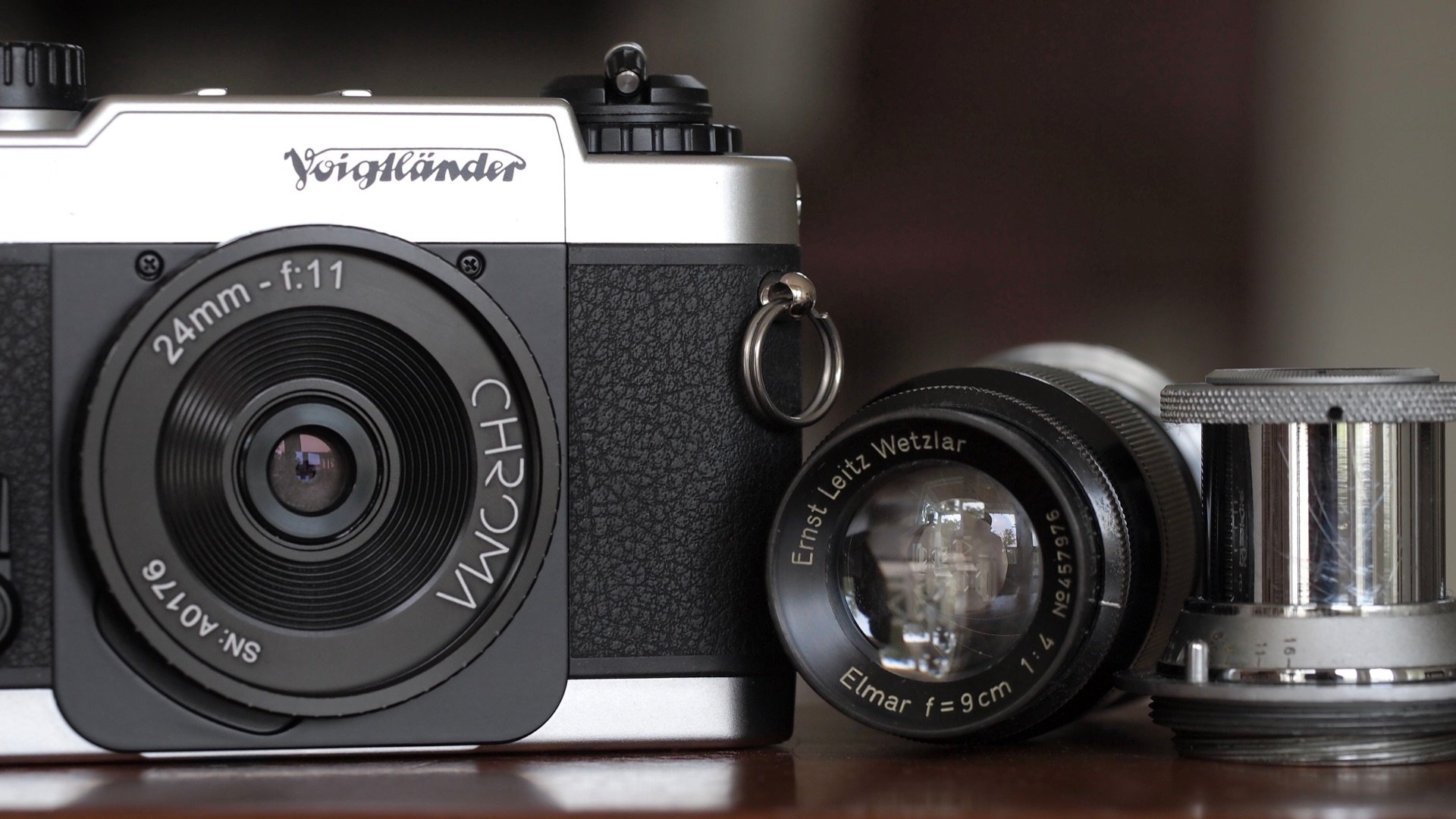

A chance encounter easily caught with the Double Glass lens. By using Kentmere 100 35mm film, you will enjoy a lovely fine grain pattern throughout the scene. Although the film processing lab, unfortunately, scratched this negative. Rats!
So, you’ve been waiting since 1930 for the perfect lens to mount on your threaded flange Leica 1(C) camera. Variously named the Leica screw mount, the Leica thread mount, M39 mount, and the L39 mount, this whatchamacallit lens mount was never gonna be perfectly personified while attached to an Elmar, Hektor, Summar, Xenon, Summitar, Summarit, or Summicron. None of these of these legendary Leica screw-mount lenses really fit the bill. Why not? Because you know the lens laundry list of requisite features by heart: focus-free, great glass, awesome aperture, and, naturally, L39 mount.
Figure 1. The OG Leica 1(C) L39 mount camera. [Photography courtesy of Smithsonian Institution National Museum of American History.]
Well, your long wait (that’s about 94 years worth of waiting; thanks for being so patient) is now over. That perfect Leica thread mount lens has finally arrived. Dubbed Double Glass, this 24mm f/11 L39 mount lens is available today for $132 from Chroma Camera.
Figure 2. The Chroma Double Glass lens mounted on a Bessa L with a pair of thread mount lenses enviously watching this modern marvel expand the Bessa L horizon.
Sold in extremely thoughtful environmentally-friendly packaging, the Double Glass lens trumps the Leica design aesthete with a gorgeous all metal/glass look that is flanked by a plastic end cap and a threaded metal lens cap. Holding this lens in your hand is like paying homage to industrial design giants like Marc Newson.
Newson’s Pentax K-01 mirrorless camera and Pentax DA 40mm f/2.8 XS K mount lens both stand out as examples of pushing the photographic equipment design envelope towards using art to make art. Therefore, you’ll have to try and curb your enthusiasm as you thread the Double Glass onto your Leica 1(C).
Ok, seriously, you might not have a Leica 1(C). Yet the prospects of using a perfect lens are just too tempting to ignore (see Figure 3). There are two options for giving you this pleasure of perfection:
Figure 3. Sitting underneath a shade tree shields the lens from overhead glare.
1. There is a large selection of L39 lens mount-to-various camera mount adapters. FotodioX, for example, has L39 adapters for Fujifilm X, Leica M, Micro Four Thirds, Nikon F, Nikon 1, and Sony E camera mounts. These adapters range in price from $9.95 to $34.95.
2. Ideally, a modern equivalent of the Leica 1(C) would be the perfect platform for gaining all of that L39 mount glass goodness without the unwanted intrusion of rangefinders, mirrors, and digital viewfinders. And the Voigtlander Bessa-L is that ideal modern camera that you need. Lacking any rangefinder/viewfinder, but featuring a through-the-lens (TTL) metering system, the L39 mount Bessa-L, like the one in Figure 4, is the soul mate for the Double Glass lens. Luckily, finding a Bessa-L in “excellent” condition on today’s used camera market isn’t too difficult and the cost should be around $200 – $400. Sacrificing some quality conditions can save you money, however.
Figure 4. An ideal companion for the Voigtlander Bessa L is the Chroma Double Glass lens.
Using a focus-free wide-angle lens with minimal distortion will be an eye-opening and photographically liberating experience (see Figures 5, 6, and 7). Similarly, not having to hold the camera to your eye for focusing and composition will transform you into a freestyle photographer–where you’ll be able to see the “entire” scene without the claustrophobic blinders of a viewfinder limiting your perspective (see Figure 8). It’s easy to see that a lens like this could rule the photographic world–and that dominating lens is the Double Glass.
Figure 5. A panoramic vista is ideal for a 24mm focus-free lens.
Figure 6. The only variable that you can control is the shutter speed.
Figure 7. An impressive depth of field can be captured with the f/11 lens.
Figure 8. You can easily check the lens’ angle of view by holding a scrap of glassine from a film negative envelope against the camera’s light box. Use the bulb shutter speed setting (B) and a cable release to hold the shutter open while viewing through the lens.
Enjoy.






